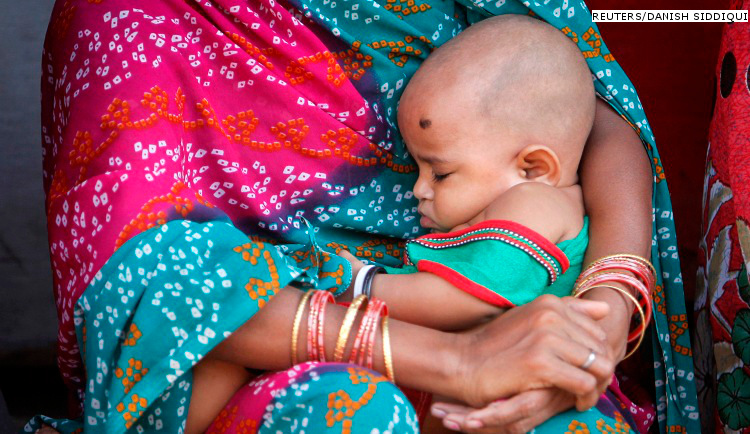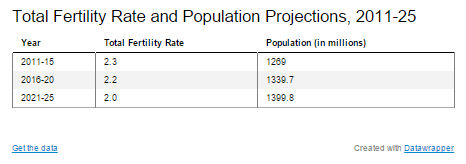Will Indian Hindus Have 4 Children?
 Bharatiya Janata Party MP Sakshi Maharaj’s demand that Hindu women should have 4 or more children to ensure Hinduism’s primacy is not reflected in India’s declining fertility rates. Maharaj said: "The concept of four wives and forty children just won't work in India, but it is high time that every Hindu woman must produce at least four children to protect the Hindu religion". Total Fertility Rate (TFR) of a population is the average number of children born to a woman during her reproductive age. According to the Registrar General, India, the total fertility rate (TFR) has declined from 2.8 in 2006 to 2.4 in 2012, which accounts for a decline of more than 14%. It has declined from 4.7 in 1970, when India’s population was 555 million. It is now more than 1.2 billion. According to some UN projections, India's population may stabilise at around 1.7 billion by 2060 with current fertility rates. The TFR in rural areas has declined from 3.1 in 2006 to 2.6 in 2012 whereas the corresponding decline in urban areas has been from 2.0 to 1.8 during the same period. The trend is clear: Indian women are producing fewer children, a trend that is only likely to accelerate. Source: Ministry of Health Total Fertility Rate, 2006 to 2012 Tamil Nadu, West Bengal, Punjab and Himachal Pradesh have the lowest TFR of 1.7 and the highest TFR recorded is 3.5 for Bihar. Eleven of 20 big states have achieved the replacement level of fertility, which is a TFR of 2.1 in 2012. This means the population of these states will stop growing—unless migration increases numbers. The states are Andhra Pradesh (1.8), Delhi (1.8), HP (1.7), J&K (1.9), Karnataka (1.9), Kerala (1.8), Odisha (2.1), Maharashtra (1.8), Punjab (1.7), Tamil Nadu (1.7) and West Bengal (1.7). Let us now look at the population trend since 1901: Source: Ministry of Health A health ministry report also has projections for TFR till 2026, and likely population based on TFR.
Bharatiya Janata Party MP Sakshi Maharaj’s demand that Hindu women should have 4 or more children to ensure Hinduism’s primacy is not reflected in India’s declining fertility rates. Maharaj said: "The concept of four wives and forty children just won't work in India, but it is high time that every Hindu woman must produce at least four children to protect the Hindu religion". Total Fertility Rate (TFR) of a population is the average number of children born to a woman during her reproductive age. According to the Registrar General, India, the total fertility rate (TFR) has declined from 2.8 in 2006 to 2.4 in 2012, which accounts for a decline of more than 14%. It has declined from 4.7 in 1970, when India’s population was 555 million. It is now more than 1.2 billion. According to some UN projections, India's population may stabilise at around 1.7 billion by 2060 with current fertility rates. The TFR in rural areas has declined from 3.1 in 2006 to 2.6 in 2012 whereas the corresponding decline in urban areas has been from 2.0 to 1.8 during the same period. The trend is clear: Indian women are producing fewer children, a trend that is only likely to accelerate. Source: Ministry of Health Total Fertility Rate, 2006 to 2012 Tamil Nadu, West Bengal, Punjab and Himachal Pradesh have the lowest TFR of 1.7 and the highest TFR recorded is 3.5 for Bihar. Eleven of 20 big states have achieved the replacement level of fertility, which is a TFR of 2.1 in 2012. This means the population of these states will stop growing—unless migration increases numbers. The states are Andhra Pradesh (1.8), Delhi (1.8), HP (1.7), J&K (1.9), Karnataka (1.9), Kerala (1.8), Odisha (2.1), Maharashtra (1.8), Punjab (1.7), Tamil Nadu (1.7) and West Bengal (1.7). Let us now look at the population trend since 1901: Source: Ministry of Health A health ministry report also has projections for TFR till 2026, and likely population based on TFR. 
Source: Ministry of Health
A Planning Commission report said an expert group estimated that the country will achieve replacement level of fertility by 2026. Bihar, Madhya Pradesh, Rajasthan and Uttar Pradesh will achieve the replacement level of fertility by the year 2039, 2060, 2048 and after 2100, respectively. So, fertility is only likely to move down across the India. Maharaj’s dreams may remain just that. Advertisement
Next Story


